Xi Yang
LadderMoE: Ladder-Side Mixture of Experts Adapters for Bronze Inscription Recognition
Oct 02, 2025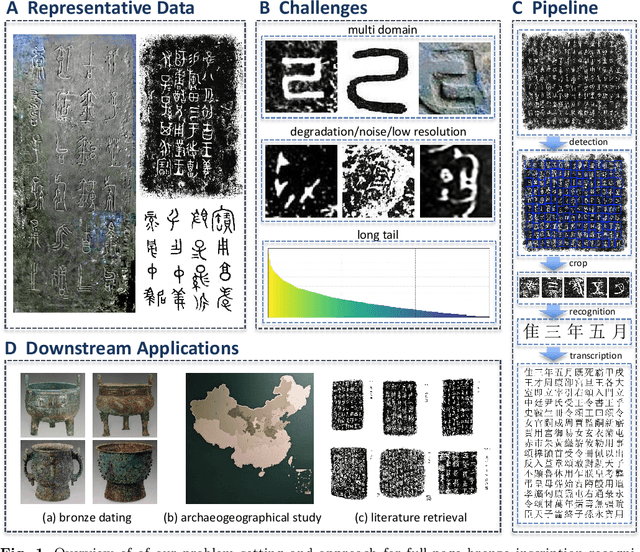

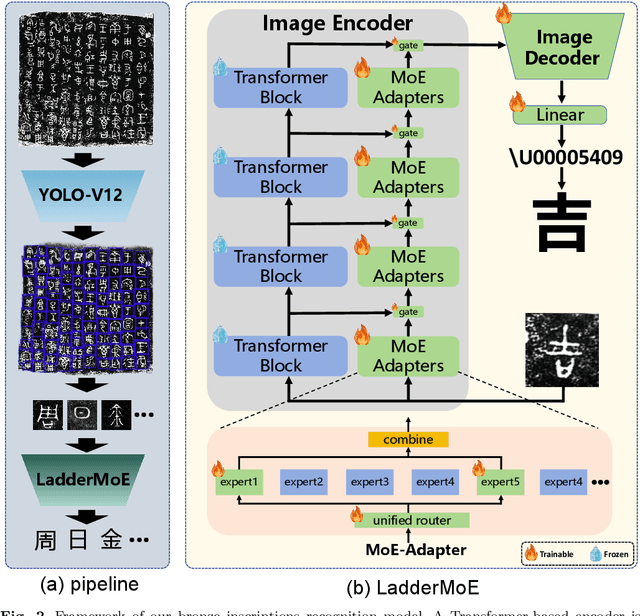

Abstract:Bronze inscriptions (BI), engraved on ritual vessels, constitute a crucial stage of early Chinese writing and provide indispensable evidence for archaeological and historical studies. However, automatic BI recognition remains difficult due to severe visual degradation, multi-domain variability across photographs, rubbings, and tracings, and an extremely long-tailed character distribution. To address these challenges, we curate a large-scale BI dataset comprising 22454 full-page images and 198598 annotated characters spanning 6658 unique categories, enabling robust cross-domain evaluation. Building on this resource, we develop a two-stage detection-recognition pipeline that first localizes inscriptions and then transcribes individual characters. To handle heterogeneous domains and rare classes, we equip the pipeline with LadderMoE, which augments a pretrained CLIP encoder with ladder-style MoE adapters, enabling dynamic expert specialization and stronger robustness. Comprehensive experiments on single-character and full-page recognition tasks demonstrate that our method substantially outperforms state-of-the-art scene text recognition baselines, achieving superior accuracy across head, mid, and tail categories as well as all acquisition modalities. These results establish a strong foundation for bronze inscription recognition and downstream archaeological analysis.
Clustering-based Feature Representation Learning for Oracle Bone Inscriptions Detection
Aug 26, 2025Abstract:Oracle Bone Inscriptions (OBIs), play a crucial role in understanding ancient Chinese civilization. The automated detection of OBIs from rubbing images represents a fundamental yet challenging task in digital archaeology, primarily due to various degradation factors including noise and cracks that limit the effectiveness of conventional detection networks. To address these challenges, we propose a novel clustering-based feature space representation learning method. Our approach uniquely leverages the Oracle Bones Character (OBC) font library dataset as prior knowledge to enhance feature extraction in the detection network through clustering-based representation learning. The method incorporates a specialized loss function derived from clustering results to optimize feature representation, which is then integrated into the total network loss. We validate the effectiveness of our method by conducting experiments on two OBIs detection dataset using three mainstream detection frameworks: Faster R-CNN, DETR, and Sparse R-CNN. Through extensive experimentation, all frameworks demonstrate significant performance improvements.
Exploiting Layer Normalization Fine-tuning in Visual Transformer Foundation Models for Classification
Aug 11, 2025Abstract:LayerNorm is pivotal in Vision Transformers (ViTs), yet its fine-tuning dynamics under data scarcity and domain shifts remain underexplored. This paper shows that shifts in LayerNorm parameters after fine-tuning (LayerNorm shifts) are indicative of the transitions between source and target domains; its efficacy is contingent upon the degree to which the target training samples accurately represent the target domain, as quantified by our proposed Fine-tuning Shift Ratio ($FSR$). Building on this, we propose a simple yet effective rescaling mechanism using a scalar $\lambda$ that is negatively correlated to $FSR$ to align learned LayerNorm shifts with those ideal shifts achieved under fully representative data, combined with a cyclic framework that further enhances the LayerNorm fine-tuning. Extensive experiments across natural and pathological images, in both in-distribution (ID) and out-of-distribution (OOD) settings, and various target training sample regimes validate our framework. Notably, OOD tasks tend to yield lower $FSR$ and higher $\lambda$ in comparison to ID cases, especially with scarce data, indicating under-represented target training samples. Moreover, ViTFs fine-tuned on pathological data behave more like ID settings, favoring conservative LayerNorm updates. Our findings illuminate the underexplored dynamics of LayerNorm in transfer learning and provide practical strategies for LayerNorm fine-tuning.
Overconfidence in LLM-as-a-Judge: Diagnosis and Confidence-Driven Solution
Aug 08, 2025Abstract:Large Language Models (LLMs) are widely used as automated judges, where practical value depends on both accuracy and trustworthy, risk-aware judgments. Existing approaches predominantly focus on accuracy, overlooking the necessity of well-calibrated confidence, which is vital for adaptive and reliable evaluation pipelines. In this work, we advocate a shift from accuracy-centric evaluation to confidence-driven, risk-aware LLM-as-a-Judge systems, emphasizing the necessity of well-calibrated confidence for trustworthy and adaptive evaluation. We systematically identify the **Overconfidence Phenomenon** in current LLM-as-a-Judges, where predicted confidence significantly overstates actual correctness, undermining reliability in practical deployment. To quantify this phenomenon, we introduce **TH-Score**, a novel metric measuring confidence-accuracy alignment. Furthermore, we propose **LLM-as-a-Fuser**, an ensemble framework that transforms LLMs into reliable, risk-aware evaluators. Extensive experiments demonstrate that our approach substantially improves calibration and enables adaptive, confidence-driven evaluation pipelines, achieving superior reliability and accuracy compared to existing baselines.
RoboBrain 2.0 Technical Report
Jul 02, 2025Abstract:We introduce RoboBrain 2.0, our latest generation of embodied vision-language foundation models, designed to unify perception, reasoning, and planning for complex embodied tasks in physical environments. It comes in two variants: a lightweight 7B model and a full-scale 32B model, featuring a heterogeneous architecture with a vision encoder and a language model. Despite its compact size, RoboBrain 2.0 achieves strong performance across a wide spectrum of embodied reasoning tasks. On both spatial and temporal benchmarks, the 32B variant achieves leading results, surpassing prior open-source and proprietary models. In particular, it supports key real-world embodied AI capabilities, including spatial understanding (e.g., affordance prediction, spatial referring, trajectory forecasting) and temporal decision-making (e.g., closed-loop interaction, multi-agent long-horizon planning, and scene graph updating). This report details the model architecture, data construction, multi-stage training strategies, infrastructure and practical applications. We hope RoboBrain 2.0 advances embodied AI research and serves as a practical step toward building generalist embodied agents. The code, checkpoint and benchmark are available at https://superrobobrain.github.io.
FlagEvalMM: A Flexible Framework for Comprehensive Multimodal Model Evaluation
Jun 10, 2025Abstract:We present FlagEvalMM, an open-source evaluation framework designed to comprehensively assess multimodal models across a diverse range of vision-language understanding and generation tasks, such as visual question answering, text-to-image/video generation, and image-text retrieval. We decouple model inference from evaluation through an independent evaluation service, thus enabling flexible resource allocation and seamless integration of new tasks and models. Moreover, FlagEvalMM utilizes advanced inference acceleration tools (e.g., vLLM, SGLang) and asynchronous data loading to significantly enhance evaluation efficiency. Extensive experiments show that FlagEvalMM offers accurate and efficient insights into model strengths and limitations, making it a valuable tool for advancing multimodal research. The framework is publicly accessible athttps://github.com/flageval-baai/FlagEvalMM.
So-Fake: Benchmarking and Explaining Social Media Image Forgery Detection
May 24, 2025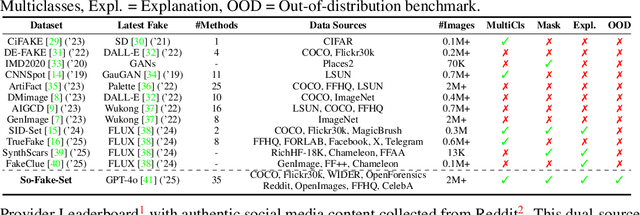
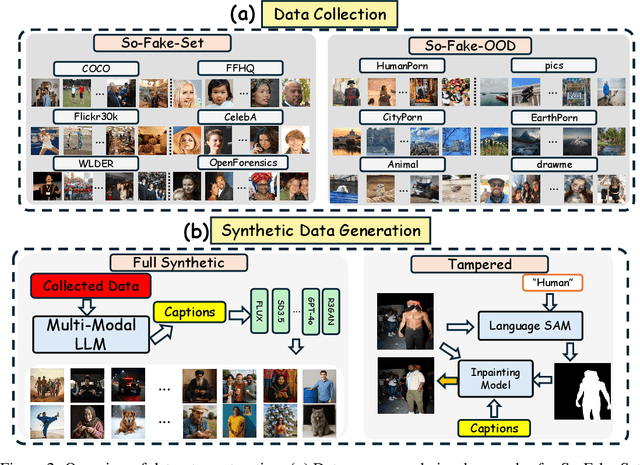
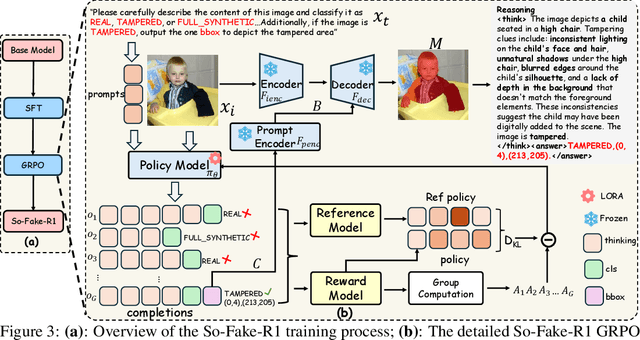
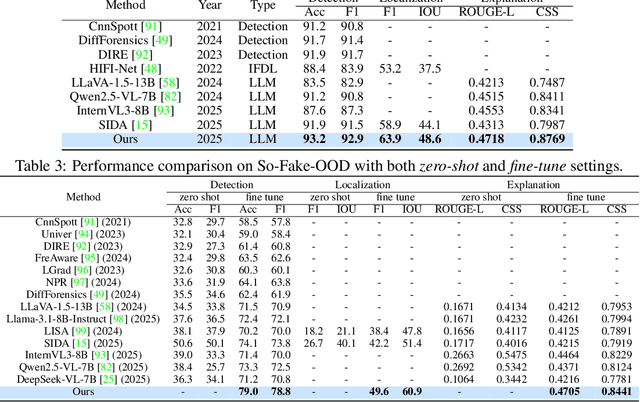
Abstract:Recent advances in AI-powered generative models have enabled the creation of increasingly realistic synthetic images, posing significant risks to information integrity and public trust on social media platforms. While robust detection frameworks and diverse, large-scale datasets are essential to mitigate these risks, existing academic efforts remain limited in scope: current datasets lack the diversity, scale, and realism required for social media contexts, while detection methods struggle with generalization to unseen generative technologies. To bridge this gap, we introduce So-Fake-Set, a comprehensive social media-oriented dataset with over 2 million high-quality images, diverse generative sources, and photorealistic imagery synthesized using 35 state-of-the-art generative models. To rigorously evaluate cross-domain robustness, we establish a novel and large-scale (100K) out-of-domain benchmark (So-Fake-OOD) featuring synthetic imagery from commercial models explicitly excluded from the training distribution, creating a realistic testbed for evaluating real-world performance. Leveraging these resources, we present So-Fake-R1, an advanced vision-language framework that employs reinforcement learning for highly accurate forgery detection, precise localization, and explainable inference through interpretable visual rationales. Extensive experiments show that So-Fake-R1 outperforms the second-best method, with a 1.3% gain in detection accuracy and a 4.5% increase in localization IoU. By integrating a scalable dataset, a challenging OOD benchmark, and an advanced detection framework, this work establishes a new foundation for social media-centric forgery detection research. The code, models, and datasets will be released publicly.
Video-SafetyBench: A Benchmark for Safety Evaluation of Video LVLMs
May 17, 2025Abstract:The increasing deployment of Large Vision-Language Models (LVLMs) raises safety concerns under potential malicious inputs. However, existing multimodal safety evaluations primarily focus on model vulnerabilities exposed by static image inputs, ignoring the temporal dynamics of video that may induce distinct safety risks. To bridge this gap, we introduce Video-SafetyBench, the first comprehensive benchmark designed to evaluate the safety of LVLMs under video-text attacks. It comprises 2,264 video-text pairs spanning 48 fine-grained unsafe categories, each pairing a synthesized video with either a harmful query, which contains explicit malice, or a benign query, which appears harmless but triggers harmful behavior when interpreted alongside the video. To generate semantically accurate videos for safety evaluation, we design a controllable pipeline that decomposes video semantics into subject images (what is shown) and motion text (how it moves), which jointly guide the synthesis of query-relevant videos. To effectively evaluate uncertain or borderline harmful outputs, we propose RJScore, a novel LLM-based metric that incorporates the confidence of judge models and human-aligned decision threshold calibration. Extensive experiments show that benign-query video composition achieves average attack success rates of 67.2%, revealing consistent vulnerabilities to video-induced attacks. We believe Video-SafetyBench will catalyze future research into video-based safety evaluation and defense strategies.
Pro2SAM: Mask Prompt to SAM with Grid Points for Weakly Supervised Object Localization
May 08, 2025Abstract:Weakly Supervised Object Localization (WSOL), which aims to localize objects by only using image-level labels, has attracted much attention because of its low annotation cost in real applications. Current studies focus on the Class Activation Map (CAM) of CNN and the self-attention map of transformer to identify the region of objects. However, both CAM and self-attention maps can not learn pixel-level fine-grained information on the foreground objects, which hinders the further advance of WSOL. To address this problem, we initiatively leverage the capability of zero-shot generalization and fine-grained segmentation in Segment Anything Model (SAM) to boost the activation of integral object regions. Further, to alleviate the semantic ambiguity issue accrued in single point prompt-based SAM, we propose an innovative mask prompt to SAM (Pro2SAM) network with grid points for WSOL task. First, we devise a Global Token Transformer (GTFormer) to generate a coarse-grained foreground map as a flexible mask prompt, where the GTFormer jointly embeds patch tokens and novel global tokens to learn foreground semantics. Secondly, we deliver grid points as dense prompts into SAM to maximize the probability of foreground mask, which avoids the lack of objects caused by a single point/box prompt. Finally, we propose a pixel-level similarity metric to come true the mask matching from mask prompt to SAM, where the mask with the highest score is viewed as the final localization map. Experiments show that the proposed Pro2SAM achieves state-of-the-art performance on both CUB-200-2011 and ILSVRC, with 84.03\% and 66.85\% Top-1 Loc, respectively.
Lightweight RGB-D Salient Object Detection from a Speed-Accuracy Tradeoff Perspective
May 07, 2025



Abstract:Current RGB-D methods usually leverage large-scale backbones to improve accuracy but sacrifice efficiency. Meanwhile, several existing lightweight methods are difficult to achieve high-precision performance. To balance the efficiency and performance, we propose a Speed-Accuracy Tradeoff Network (SATNet) for Lightweight RGB-D SOD from three fundamental perspectives: depth quality, modality fusion, and feature representation. Concerning depth quality, we introduce the Depth Anything Model to generate high-quality depth maps,which effectively alleviates the multi-modal gaps in the current datasets. For modality fusion, we propose a Decoupled Attention Module (DAM) to explore the consistency within and between modalities. Here, the multi-modal features are decoupled into dual-view feature vectors to project discriminable information of feature maps. For feature representation, we develop a Dual Information Representation Module (DIRM) with a bi-directional inverted framework to enlarge the limited feature space generated by the lightweight backbones. DIRM models texture features and saliency features to enrich feature space, and employ two-way prediction heads to optimal its parameters through a bi-directional backpropagation. Finally, we design a Dual Feature Aggregation Module (DFAM) in the decoder to aggregate texture and saliency features. Extensive experiments on five public RGB-D SOD datasets indicate that the proposed SATNet excels state-of-the-art (SOTA) CNN-based heavyweight models and achieves a lightweight framework with 5.2 M parameters and 415 FPS.
 Add to Chrome
Add to Chrome Add to Firefox
Add to Firefox Add to Edge
Add to Edge